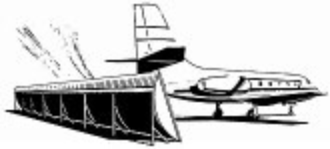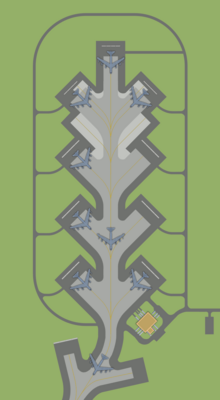50:
151:, which have engines mounted in the tail above the fuselage. Airports often place their deflectors at the beginnings of runways, especially when roadways or structures are adjacent. Airports that are in dense urban areas often have deflectors between taxiways and airport borders. Jet blast deflectors usually direct exhaust gases upward. However, a low-pressure zone can form behind the blast fence, causing ambient air and debris to be drawn upward with the jet exhaust, and hot, toxic gases to circulate behind the blast fence. Jet blast deflectors have been designed to counteract this problem by using multiple panels and various angles, and by using slotted panel surfaces.
196:
28:
177:
127:
39:
243:
active cooling systems were installed in the 1970s, tapping the fire mains (fire suppression water systems) to use seawater circulating through water lines within the deflector panel. However, the water cooling system adds more complexity and failure points, and requires additional maintenance. The most recent method tried by the
49:
108:
High energy jet engine exhaust can cause injury and damage. Jet blast has been known to uproot trees, shatter windows, overturn automobiles and trucks, flatten poorly made structures and injure people. Other aircraft in the jet blast, especially lightweight ones, have been blown around and damaged by
234:
until the aircraft to be launched rolls over it on the way to the catapult. When the aircraft is clear of the deflector, the heavy panel is raised into position to redirect the hot jet blast. As soon as the deflector is raised, another aircraft can be brought into position behind it, and flight deck
142:
Jet blast deflectors began to appear at airports in the 1950s. Airports in the 1960s used jet blast deflectors with a height of 6 to 8 feet (1.8 to 2.4 m), but airports in the 1990s needed deflectors that were twice as high, and even up to 35 feet (11 m) high for jet airliners such as the
242:
exhaust. The non-skid decking surface of the deflector suffers heat damage and requires frequent maintenance or replacement. Additionally, the hot deflector surface cannot be used as normal decking until it has cooled enough to allow aircraft tires to roll over it. To mitigate the heat problem,
266:
A jet blast deflector is often called simply a "blast deflector", however, this term has other uses. In gunnery, the term "blast deflector" refers to a device which protects the gun crew from the muzzle blast of a gun. In small arms, a "blast deflector" is another name for a
163:
to full thrust to test it. Rural airports rarely provide more than a distant portion of the airfield within which to test engines at full thrust, but urban airports surrounded by residential areas often specify that engine tests be conducted within a ground run-up enclosure
117:
engines combine to create a thrust of approximately 200,000 pounds-force (900,000 N), a level of force which is high enough to kill people. To prevent these problems, jet blast deflectors redirect the air stream in a non-dangerous direction, frequently upward.
235:
personnel can perform final readiness duties without the danger of hot, violent exhaust gases. Such systems were installed on aircraft carriers in the late 1940s and early 1950s, as jet-powered aircraft began to appear in navies.
83:
Jet blast deflectors range in complexity from stationary concrete, metal or fiberglass fences to heavy panels that are raised and lowered by hydraulic arms and actively cooled. Blast deflectors can be used as protection from
109:
jet exhaust. Hurricane-force air streams moving at speeds up to 100 knots (190 km/h; 120 mph) have been measured behind the largest jet-powered aircraft at distances of over 200 feet (60 m). A
258:. The tiled panels can be changed quickly and easily – the ship carries a large replacement supply. Without active water lines, the passively-tiled deflector is expected to require much less maintenance.
76:
to prevent damage and injury. The structure must be strong enough to withstand heat and high speed air streams as well as dust and debris carried by the turbulent air. Without a deflector,
485:
USS Oriskany (CV-34) began a major refit in
October 1947 and was returned to service in August 1951 with a number of modernizations including jet blast deflectors.
478:
185:
222:, positioned to protect other aircraft from exhaust blast damage. Jet blast deflectors are made of heavy duty material that is raised and lowered by
255:
298:
195:
238:
Jet blast deflectors aboard aircraft carriers are placed in very close proximity to the 2,300 °F (1,300 °C) temperatures of
543:
100:
walls to form a ground run-up enclosure within which a jet aircraft engine can safely and more quietly be tested at full thrust.
560:
248:
239:
200:
280:
475:
131:
565:
271:
which directs muzzle blast to the sides and upward to prevent the muzzle from climbing during automatic fire.
148:
144:
291:
254:
which uses heavy-duty metal panels covered in heat-dissipating ceramic tiles similar to those used on the
135:
176:
114:
27:
126:
89:
159:
After a jet engine has been overhauled or has undergone the replacement of parts, it is normal to
522:
355:
244:
223:
539:
219:
160:
215:
54:
482:
227:
554:
208:
97:
268:
181:
53:
An airman services a jet blast deflector (JBD) before flight operations aboard an
285:
231:
503:
461:
435:
411:
392:
373:
328:
165:
110:
85:
73:
38:
77:
17:
96:
and jet engine service centers, jet blast deflectors can be combined with
230:. The jet blast deflector lies flush with and serves as a portion of the
497:
Fischer, Eugene C. and Dale A. Sowell, John Wehrle, Peter O. Cervenka.
93:
43:
80:
can be dangerous to people, equipment, vehicles and other aircraft.
31:
Jet Blast
Deflector providing service at Rionegro Airport, Colombia.
194:
175:
125:
48:
37:
26:
72:
is a safety device that redirects the high energy exhaust from a
207:, a jet blast deflector is raised hydraulically to protect an
499:
Cooled jet blast deflectors for aircraft carrier flight decks
294:—accident caused in part by the lack of a jet blast barrier
168:"), so that the engine noise can be reduced for residents.
247:
for solving the heat problem was introduced in 2008 with
35:
Safety device that redirects exhaust from a jet engine
138:, showing the positioning of the jet blast deflectors
536:
Ballistics: Theory and Design of Guns and
Ammunition
517:
515:
513:
288:—a jet accident within a ground run-up enclosure
525:July 10, 2006. Retrieved on November 14, 2009.
451:
449:
447:
445:
318:
316:
314:
8:
534:Carlucci, Donald E. and Sidney S. Jacobson.
346:
344:
342:
340:
338:
493:
491:
425:
423:
421:
218:use jet blast deflectors at the rear of
324:Split exhaust jet blast deflector fence
310:
286:Etihad Airways A340-600 F-WWCJ accident
191:, with the jet blast deflector deployed
299:Princess Juliana International Airport
7:
474:Federation of American Scientists.
25:
538:, pp. 158–159. CRC Press, 2007.
358:Retrieved on November 13, 2009.
354:, Issue Number 6, August 1993.
184:preparing for take-off on the
1:
476:"CV-9 Essex Class: Overview."
523:"CVN-77 - George H.W. Bush."
465:, issued September 18, 1984.
388:Jet engine exhaust deflector
42:A typical blast fence at an
377:, issued December 13, 1955.
369:Blast fence for jet engines
211:from the exhaust of another
582:
356:"Ground Jet Blast Hazard."
281:Index of aviation articles
429:Campion, Gordon Pearson.
407:Jet blast deflector fence
186:Russian aircraft carrier
439:issued October 12, 2004.
396:, issued March 11, 1958.
507:, issued June 10, 2003.
155:Ground run-up enclosure
145:McDonnell Douglas DC-10
561:Airport infrastructure
457:Blast deflecting fence
415:, issued July 7, 1992.
332:, issued July 4, 1995.
292:Air Moorea Flight 1121
212:
192:
139:
136:Glasgow Air Force Base
57:
46:
32:
504:U.S. patent 6,575,113
462:U.S. patent 4,471,924
436:U.S. patent 6,802,477
412:U.S. patent 5,127,609
393:U.S. patent 2,826,382
374:U.S. patent 2,726,830
329:U.S. patent 5,429,324
198:
179:
130:An illustration of a
129:
115:General Electric GE90
52:
41:
30:
521:GlobalSecurity.org.
224:hydraulic cylinders
199:In 2003 aboard the
90:fixed-wing aircraft
62:jet blast deflector
481:2011-03-10 at the
386:Hayden, Harold J.
350:Morrison, Rowena.
245:United States Navy
240:modern jet fighter
220:aircraft catapults
213:
193:
140:
58:
47:
33:
455:Stanley, Lynn B.
405:Stanley, Lynn B.
367:Brown, Edward L.
322:Stanley, Lynn B.
216:Aircraft carriers
188:Admiral Kuznetsov
172:Aircraft carriers
161:run the engine up
16:(Redirected from
573:
546:
532:
526:
519:
508:
506:
495:
486:
472:
466:
464:
453:
440:
438:
427:
416:
414:
403:
397:
395:
384:
378:
376:
365:
359:
348:
333:
331:
320:
251:George H.W. Bush
228:linear actuators
55:aircraft carrier
21:
581:
580:
576:
575:
574:
572:
571:
570:
566:Aviation safety
551:
550:
549:
533:
529:
520:
511:
502:
496:
489:
483:Wayback Machine
473:
469:
460:
454:
443:
434:
431:Blast deflector
428:
419:
410:
404:
400:
391:
385:
381:
372:
366:
362:
352:ASRS Directline
349:
336:
327:
321:
312:
308:
277:
264:
262:Blast deflector
203:Abraham Lincoln
174:
157:
124:
106:
98:sound-deadening
36:
23:
22:
15:
12:
11:
5:
579:
577:
569:
568:
563:
553:
552:
548:
547:
527:
509:
487:
467:
441:
417:
398:
379:
360:
334:
309:
307:
304:
303:
302:
295:
289:
283:
276:
273:
263:
260:
205: (CVN-72)
173:
170:
156:
153:
132:Christmas tree
123:
120:
105:
102:
34:
24:
14:
13:
10:
9:
6:
4:
3:
2:
578:
567:
564:
562:
559:
558:
556:
545:
544:1-4200-6618-8
541:
537:
531:
528:
524:
518:
516:
514:
510:
505:
500:
494:
492:
488:
484:
480:
477:
471:
468:
463:
458:
452:
450:
448:
446:
442:
437:
432:
426:
424:
422:
418:
413:
408:
402:
399:
394:
389:
383:
380:
375:
370:
364:
361:
357:
353:
347:
345:
343:
341:
339:
335:
330:
325:
319:
317:
315:
311:
305:
300:
296:
293:
290:
287:
284:
282:
279:
278:
274:
272:
270:
261:
259:
257:
256:Space Shuttle
253:
252:
246:
241:
236:
233:
229:
225:
221:
217:
210:
209:F/A-18 Hornet
206:
204:
197:
190:
189:
183:
178:
171:
169:
167:
162:
154:
152:
150:
146:
137:
133:
128:
121:
119:
116:
112:
103:
101:
99:
95:
92:propwash. At
91:
87:
81:
79:
75:
71:
67:
63:
56:
51:
45:
40:
29:
19:
535:
530:
498:
470:
456:
430:
406:
401:
387:
382:
368:
363:
351:
323:
269:muzzle brake
265:
250:
237:
214:
202:
187:
182:Sukhoi Su-33
158:
141:
107:
82:
69:
65:
61:
59:
232:flight deck
70:blast fence
18:Blast fence
555:Categories
306:References
166:hush house
111:Boeing 777
86:helicopter
74:jet engine
297:Death at
201:USS
78:jet blast
479:Archived
301:in 2017.
275:See also
122:Airports
94:airports
113:'s two
104:Purpose
44:airport
542:
149:MD-11
68:) or
540:ISBN
249:USS
147:and
88:and
226:or
134:at
66:JBD
557::
512:^
501:.
490:^
459:.
444:^
433:.
420:^
409:.
390:.
371:.
337:^
326:.
313:^
180:A
164:("
60:A
64:(
20:)
Text is available under the Creative Commons Attribution-ShareAlike License. Additional terms may apply.





